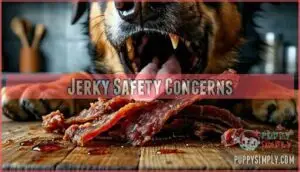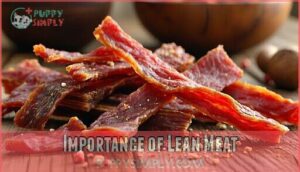This site is supported by our readers. We may earn a commission, at no cost to you, if you purchase through links.

Dog-specific jerky made with plain, unseasoned meat is generally safe and even offers health benefits like protein and dental support.
However, many types of human jerky are loaded with salt, spices, and toxic ingredients like onion, garlic, or even xylitol, which can be dangerous for dogs.
Always check the label or stick to jerky made for pets. And remember, moderation is key—too much jerky, even the good kind, can upset their stomach.
Curious about homemade options? It might just be your paw-fect solution!
Table Of Contents
- Key Takeaways
- Jerky Safety Concerns
- Can Dogs Eat Jerky
- Health Benefits Explained
- Risks of Human Jerky
- Safe Feeding Practices
- Jerky Ingredients Matter
- Homemade Jerky Options
- Commercial Jerky Alternatives
- Common Jerky Mistakes
- Healthy Jerky Choices
- Frequently Asked Questions (FAQs)
- Is beef jerky bad for dogs?
- Can dogs eat jerky?
- Can dogs eat beef jerky sticks?
- Are beef jerky treats good for dogs?
- Can dogs eat Slim Jim beef jerky?
- Can dogs eat peppered beef jerky?
- What happens if a dog eats the thing in beef jerky?
- Can jerky cause blockage in dogs?
- How much beef jerky should I feed my dog?
- How often can I give my dog beef jerky?
- Conclusion
Key Takeaways
- Stick to plain, dog-specific jerky or make it at home without harmful ingredients like onion, garlic, xylitol, or excessive salt.
- Avoid sharing human jerky since it often contains toxic additives and high sodium levels that can harm your dog.
- Feed jerky to your dog in moderation, making sure it doesn’t exceed 10% of their daily calorie intake.
- Monitor your dog for signs of adverse reactions such as vomiting, diarrhea, or unusual behavior after eating jerky.
Jerky Safety Concerns
You’ll need to be careful with jerky treats as many commercial products contain toxic ingredients like onions, garlic, and high sodium that can harm your dog.
The chewy texture can also pose a choking hazard, especially for dogs who gulp their food without properly chewing.
Toxic Ingredients
Lurking within many store-bought jerky products are toxic ingredients that can harm your dog.
Onion and garlic, common jerky seasonings, can damage your pet’s red blood cells and lead to anemia.
Jack Link’s and similar brands often contain these dangerous additives alongside xylitol, which can be deadly for dogs.
Jerky loaded with preservatives and chemicals like nitrates poses significant health risks, potentially causing severe digestive issues and long-term organ damage.
High Sodium Content
While toxic additives are concerning, the sodium content in commercial jerky is equally alarming for your dog.
The concerning sodium levels in commercial jerky can silently damage your dog’s health while they happily munch away.
A single piece can contain over 400mg of sodium—far exceeding safe limits for dogs.
This excessive sodium intake can cause hypernatremia, kidney damage, and dehydration risks.
Watch for increased thirst and urination, early warning signs of salt toxicity.
Moderation tips: always choose low-sodium options made specifically for canine consumption to prevent sodium poisoning.
Choking Hazards
Giving your dog jerky poses a significant choking risk due to its dense, chewy texture.
When dogs gulp treats without proper chewing, pieces can lodge in their throat or cause digestive blockages. Always supervise your pup while they enjoy jerky, breaking larger pieces into smaller, manageable bites.
Proper hydration helps soften the treat, making it easier to swallow and reducing swallowing difficulties. Never leave your dog alone with jerky treats.
Dog-specific jerky is safer because it avoids toxic ingredients for dogs, which is a critical consideration for dog owners, and provides a healthier alternative.
Can Dogs Eat Jerky
Now that you understand the dangers, you’re probably wondering—can dogs actually eat jerky? The short answer is yes, but with important qualifications.
Dogs can safely enjoy jerky that’s:
- Made specifically for dogs with no harmful additives
- Homemade from plain, lean meat without seasonings
- Free from onions, garlic, excessive sodium, and xylitol
Not all jerky treats are created equal. Dog-specific jerky offers excellent nutritional value while minimizing risks associated with human versions.
The jerky preparation methods matter substantially—dehydration preserves nutrients while eliminating harmful bacteria.
When considering jerky for dogs as regular treats, remember that moderation is key. Proper jerky storage tips include keeping treats in airtight containers away from moisture.
While quality dog jerky may have a higher cost analysis initially, the health benefits often outweigh cheaper alternatives with questionable ingredients. Establishing appropriate jerky treat frequency helps maintain your dog’s health balance.
Health Benefits Explained
You’ll be surprised to learn that quality dog-specific jerky treats offer substantial health benefits beyond just being a tasty reward.
The high protein content supports muscle development while the chewy texture helps reduce plaque buildup, making jerky a functional treat when you choose varieties without harmful additives, as it provides a tasty reward.
High Protein Content
Your dog packs in serious nutrition with every bite of quality jerky treats.
The high protein content supports muscle growth and tissue repair, making these treats more than just a tasty reward.
| Protein Benefit | Impact on Dogs | Recommended Amount |
|---|---|---|
| Muscle Growth | Builds lean muscle mass | 10% of daily calories |
| Tissue Repair | Accelerates healing | 1-2 small pieces daily |
| Energy Source | Sustained energy levels | Based on dog’s size |
| Satiety Benefits | Keeps dogs feeling fuller | As occasional treats |
The high protein content is crucial for the dog’s health, and these treats provide a tasty reward while supporting muscle growth and tissue repair.
Dental Health Benefits
While your dog enjoys those tasty jerky treats, they’re actually getting dental benefits too.
The consistent chewing action required to eat jerky helps reduce plaque and tartar buildup on your pup’s teeth.
This natural scraping effect promotes better gum stimulation and breath improvement. Unlike soft treats that stick to teeth, chewy dog treats like jerky create friction that helps maintain your pet’s dental health between brushings.
Essential Vitamins and Minerals
Several essential vitamins and minerals in quality dog jerky support your pup’s overall health.
Iron promotes healthy red blood cells, while zinc boosts immune support.
You’ll also find B vitamins that aid in energy production and mineral absorption.
The dehydration process preserves these nutrients in their natural state, making jerky nutrition particularly beneficial compared to heavily processed treats.
Your dog’s body can efficiently utilize these jerky benefits for peak wellness.
It’s worth noting that supplement effectiveness varies, so consulting with a vet is advisable to understand the supplement effectiveness and ensure the best overall health for your dog.
Risks of Human Jerky
You’ll risk your dog’s health by sharing your beef jerky snack, as human versions contain dangerous levels of sodium and toxic ingredients like onion, garlic, and sometimes xylitol.
That single piece of store-bought jerky can deliver over 400mg of sodium to your pet, potentially causing everything from digestive upset to serious organ damage.
Onion and Garlic Toxicity
While protein-rich jerky offers health benefits, many store-bought versions contain hidden dangers.
Onion and garlic, common in human jerky, are seriously toxic to dogs. These allium family ingredients destroy red blood cells, causing anemia even in small amounts.
Symptoms of onion poisoning or garlic effects include weakness, vomiting, and breathing difficulties. The toxicity levels increase with regular exposure, making jerky with these toxic ingredients particularly dangerous.
Always check labels for these harmful additives.
Xylitol Poisoning
While harmful compounds in onions and garlic pose serious risks, xylitol presents an even deadlier threat.
This sugar substitute found in some flavored jerky can cause rapid hypoglycemia in dogs within 30 minutes of consumption.
Even small amounts can be fatal, potentially leading to death within an hour.
If your dog eats jerky containing xylitol, you’ll need immediate veterinary intervention – there’s simply no time to wait.
Preservative Dangers
Examining the preservative dangers in human jerky reveals significant risks for your furry friend.
Commercial beef jerky often contains chemical preservatives that dogs simply can’t process like humans.
- BHA and BHT preservatives can cause liver and kidney damage over time
- Sodium nitrite may lead to methemoglobinemia, reducing oxygen in the blood
- Artificial colors and flavors commonly trigger allergic reactions
These jerky ingredients pose both immediate threats and long-term effects on dog safety, highlighting the importance of being aware of the potential health risks.
Safe Feeding Practices
You’ll need to approach feeding jerky to your dog with the same caution you’d use when introducing any new treat to their diet.
When done correctly, you can safely share appropriate jerky with your furry friend while avoiding the potential hazards that come with improper selection or overfeeding.
Choosing Dog-Specific Jerky
Always check ingredient labels when selecting jerky for dogs. Choose dog-specific jerky made in the USA with high-quality, natural ingredients and no artificial additives.
The best dog jerky is rich in protein without fillers like vegetable glycerin or brown rice syrup. Consider your dog’s age and size when selecting treats—small dogs need bite-sized options with appropriate jerky texture.
Brand reputation matters, so research companies with stringent quality control measures. Excessive sodium can be a concern, so opt for low-sodium jerky options, and look for high-quality ingredients to ensure your dog’s health and safety, with a focus on natural ingredients.
Moderation Guidelines
Now that you’ve found dog-specific jerky, let’s talk about how much to give your furry friend.
The 10% rule applies here – treats like jerky should make up no more than 10% of your dog’s daily calorie intake.
For a medium-sized dog, that’s typically just one small piece per day.
Remember to provide plenty of water with jerky treats and consult your vet about appropriate serving sizes, following the daily calorie intake guideline.
Monitoring for Adverse Reactions
Vigilance is key when introducing jerky to your dog’s diet.
Watch for these adverse reactions after feeding:
- Excessive thirst or urination (signs of sodium issues)
- Vomiting or diarrhea (digestive issues from ingredients)
- Lethargy or unusual behavior (potential toxicity)
- Scratching, hives, or swelling (allergic reactions)
If you notice any concerning symptoms, discontinue jerky immediately and consult your veterinarian.
Some reactions may take hours to appear, so monitor your dog closely after trying new treats.
Jerky Ingredients Matter
You’ll need to check every ingredient on that jerky package before offering it to your furry friend.
What’s perfectly safe for you can contain harmful additives like onions, garlic, or excessive sodium that can make your dog seriously ill.
Avoiding Harmful Additives
Now that you know how to feed jerky safely, let’s focus on what shouldn’t be in your dog’s treats.
When checking jerky labels, be vigilant about harmful additives that could make your pup sick.
| Additive to Avoid | Why It’s Dangerous |
|---|---|
| Onion/Garlic Powder | Toxic to dogs’ red blood cells |
| Xylitol | Can cause rapid insulin release and liver failure |
| High Sodium | Leads to excessive thirst and potential poisoning |
| Chemical Preservatives | Can cause digestive upset |
| Added Sugars | Contribute to obesity and dental issues |
Importance of Lean Meat
When selecting jerky for your dog, lean meat is essential.
Fatty cuts can cause digestive upset or even pancreatitis in sensitive pups.
Lean protein supports muscle health and weight control while being more digestible.
Choose jerky made from lean cuts of meat to provide a concentrated energy source that helps with muscle growth without unnecessary fat.
This makes jerky a valuable protein source in your dog’s diet when fed appropriately.
Low Sodium Requirements
While lean meat forms the base of healthy dog jerky, sodium content presents a major concern.
Commercial jerky often contains excessive salt, putting your dog at risk for sodium toxicity and hypernatremia.
Dogs have substantially lower safe limits for sodium intake than humans do, and excess sodium can damage kidney health and lead to dangerous dehydration.
Always check labels for sodium content—ideally under 100mg per serving—and provide plenty of water when offering jerky for dogs, as a balanced diet also needs essential fatty acids for ideal health.
Homemade Jerky Options
You can make safe, healthy jerky for your dog at home using lean meats without the harmful additives found in commercial products.
Creating your own treats lets you control exactly what goes into your pet’s snacks, ensuring they’re getting protein-packed goodies without any dangerous ingredients like salt, onion, or garlic.
Recipes and Instructions
When making homemade dog jerky, you’ll need simple equipment and quality ingredients for best results. Creating these dogfriendly snacks is surprisingly cost-effective compared to store options.
For consistent results, consider using a dedicated jerky maker.
Follow these basic steps for perfect homemade beef jerky:
- Slice lean meat against the grain into ¼-inch strips
- Set your dehydrator to 165°F (or oven to 200°F)
- Dry for approximately 6 hours, rotating occasionally for even drying, to achieve perfect homemade beef jerky with a dedicated jerky maker and simple equipment.
Safety Precautions
Now that you have your recipes, let’s talk safety when making jerky for dogs. The kitchen can be a minefield of potential hazards when preparing these treats.
| Safety Concern | Risk Level | Prevention Step |
|---|---|---|
| Bacterial Contamination | High | Thorough cooking at 165°F |
| Cross-contamination | Medium | Separate prep surfaces |
| Ingredient Awareness | High | Avoid onions, garlic, salt |
| Dehydrator Safety | Low | Follow manufacturer guidelines |
Always prioritize hydration importance when feeding jerky. Moderation matters—too much can upset your pup’s stomach. Monitor for any reactions and seek vet consultation if needed.
Nutritional Benefits
Now that you’ve taken precautions, homemade jerky offers impressive nutritional benefits for your furry friend.
Dogs thrive on the lean protein content that supports their overall wellness.
When prepared correctly, homemade jerky provides:
- High-quality protein for muscle growth and tissue repair
- Essential minerals like iron and zinc for immune system support
- Concentrated nutrients without fillers or additives that contribute to weight management
Your dog gets maximum health benefits from minimal ingredients, which is a key aspect of homemade jerky, providing muscle growth.
Commercial Jerky Alternatives
You’ll find plenty of specially formulated jerky treats for your furry friend in pet stores that don’t contain the harmful ingredients found in human versions.
These commercial alternatives are specifically designed with your dog’s health in mind, offering the protein benefits of jerky without the dangerous levels of sodium, spices, or preservatives that can harm your pet, providing a safe way to give your dog the jerky they love, made with your dog’s health in mind.
Dog-Friendly Brands
After exploring homemade options, you might wonder which commercial brands make safe jerky for dogs.
Several companies have stepped up to create healthy dog treats specifically formulated for our furry friends.
| Brand | Key Features | Price Range |
|---|---|---|
| Campfire Treats | All-natural, antibiotic-free | Premium |
| Farm Hounds | 100% grass-fed, single-ingredient | High |
| Honest Paws | USA-raised meat, grain-free | Moderate |
| Pet Jerky Factory | Human-grade, limited ingredients | Moderate |
| O.T.I.S. | Sustainable, farm-raised game meats | Premium |
It is important to research various jerky brands before making a purchase. Brand reputation matters when choosing safe jerky for your dog.
Ingredient Checks
Every commercial jerky package requires thorough ingredient list checking before feeding it to your dog.
Always scan for toxic ingredients like onion powder, garlic, xylitol, and artificial flavors that can harm your furry friend.
Check sodium levels, which should be minimal for canine consumption. Watch for hidden sugars and various preservative types that might upset your dog’s stomach.
A jerky ingredient checker can simplify this process. When in doubt, put that package back on the shelf.
Price and Quality Considerations
Generally, you’ll find that higher-priced jerky treats often reflect better quality and sourcing.
When comparing value vs. cost for dog-friendly jerky, consider:
- Brand reputation from established dog food companies
- Processing methods that preserve nutrients without harmful additives
- Ingredient sourcing transparency, especially with natural or human-grade jerky
Homemade jerky treats can offer long-term savings, costing as little as $0.056/oz compared to $0.60/oz for store-bought options, providing a significant cost advantage.
Common Jerky Mistakes
You’ll often unknowingly put your dog’s health at risk by making common jerky mistakes like offering human-grade treats loaded with toxic ingredients or ignoring portion control.
Even the most loving pet parents can accidentally overlook warning signs of jerky sensitivity or allergic reactions that require immediate veterinary attention, which can lead to serious health issues if not addressed promptly with immediate veterinary attention.
Overfeeding Risks
While dog-friendly jerky options are available, beware of calorie overload.
Even healthy treats can lead to weight gain when overfed. Your dog’s digestive system faces unnecessary strain from excess protein, potentially causing digestive issues and nutrient imbalance.
Too many jerky treats can contribute to serious jerky risks like hypernatremia or even kidney failure.
Remember the golden rule of moderation – treats should never exceed 10% of your dog’s daily caloric intake.
Ignoring Allergies
Awareness of potential food allergies could save your dog from serious health issues when feeding jerky treats. Many pet owners miss the warning signs of allergic reactions or fail to think about breed predisposition to certain proteins.
Here’s what to watch for:
- Excessive itching or swelling after jerky consumption
- Digestive upset including vomiting or diarrhea
- Difficulty breathing, which could indicate anaphylaxis
Identifying allergens through proper allergy testing and making appropriate dietary changes is essential for your dog’s safety.
Disregarding Veterinary Advice
Bypassing your veterinarian’s advice about jerky treats is playing with fire.
Your vet understands your dog’s unique health needs, breed predispositions, and potential allergens. Many owners ignore symptoms of jerky toxicity or dismiss dosage concerns because of conflicting opinions online.
Remember, veterinarians have seen the devastating effects of jerky poisoning firsthand. Always prioritize professional guidance over internet advice regarding your dog’s health and safety, as it is crucial for preventing devastating effects.
Healthy Jerky Choices
You’ll find that plain, unseasoned jerky made specifically for dogs offers the safest option when treating your furry friend.
For best health benefits, choose products with single-source protein and no harmful additives like onions, garlic, or high sodium content.
Plain and Unseasoned Options
Plain, unseasoned jerky treats represent the gold standard for your dog’s snacking needs.
When choosing jerky for dogs, look for single-ingredient options made from lean meats without salt or spices.
Many homemade recipes allow for safe preparation that eliminates harmful additives.
Your dog’s health depends on these simpler choices that still satisfy their cravings.
Quality dog diet additions don’t need fancy flavors—just pure protein that supports their overall wellbeing, which is why lean meats are preferred.
Limited Ingredient Diets
Choosing limited ingredient jerky becomes essential when dealing with dogs who’ve food sensitivities.
These specially formulated treats contain fewer components, making it easier to identify and avoid allergens during diet trials or elimination diets.
- Single-source novel proteins like venison or rabbit that haven’t been in your dog’s regular rotation
- Treats free from common allergens such as wheat, corn, and soy
- Clearly labeled packaging that lists every ingredient without hiding additives behind vague terms
Consultation With Veterinarians
A quick call with your veterinarian can save you countless worries when introducing jerky to your dog’s diet.
Virtual consults offer immediate guidance without requiring clinic visits, while telehealth platforms provide personalized advice for dogs with allergies, sensitivities, or existing conditions.
For specific breeds with unique dietary needs, online veterinarians can develop customized care plans through video calls—ensuring your dog’s health remains the priority.
Frequently Asked Questions (FAQs)
Is beef jerky bad for dogs?
It’s ironic how something tasty for you can be risky for your dog.
Beef jerky with salt, spices, or additives is unsafe.
Stick to plain, dog-specific jerky or homemade, ensuring it’s free of harmful ingredients.
Can dogs eat jerky?
Dogs can eat jerky, but it must be dog-specific or homemade without harmful ingredients like onion, garlic, or xylitol.
Avoid human jerky, which is often too salty or spiced, risking serious health problems.
Can dogs eat beef jerky sticks?
Beef jerky sticks can be safe for dogs if they’re made specifically for pets, containing no harmful ingredients like onion, garlic, or xylitol.
Always check the label and feed in moderation to avoid issues.
Are beef jerky treats good for dogs?
Beef jerky treats can be great for dogs if they’re made specifically for pets.
They’re packed with protein, but avoid those with harmful additives like onion, garlic, or xylitol.
Stick to plain, dog-friendly options.
Can dogs eat Slim Jim beef jerky?
Slim Jims aren’t safe for dogs.
They’re loaded with salt, spices, and preservatives that can upset your pup’s stomach or cause serious health problems.
Stick to plain, dog-specific jerky to keep them happy and healthy.
Can dogs eat peppered beef jerky?
Imagine this scenario: you’re tempted to share peppered beef jerky, but hold back!
The pepper can upset your dog’s stomach or cause discomfort.
Stick to plain, unseasoned jerky instead—it’s safer and keeps your pup happy.
What happens if a dog eats the thing in beef jerky?
If your dog eats harmful ingredients in beef jerky, like garlic, onion, or xylitol, it can cause serious health issues—think upset stomach, dehydration, or worse.
Contact your vet immediately if symptoms appear.
Can jerky cause blockage in dogs?
Feeding jerky to dogs can sometimes cause blockages due to its dense, chewy texture, especially if your dog gulps food or eats large pieces.
Always monitor portion sizes and supervise to prevent choking or complications.
How much beef jerky should I feed my dog?
Limit beef jerky treats to no more than 10% of your dog’s daily calories.
Stick with dog-specific jerky or plain, unseasoned beef jerky in moderation.
Always provide fresh water and monitor for choking risks.
How often can I give my dog beef jerky?
You can give your dog beef jerky as an occasional treat, about 1-2 times per week.
Keep portions small and make certain it’s plain, low in sodium, and free from spices or harmful additives.
Conclusion
Regarding jerky for your dog, think of it like walking a fine line—careful steps make all the difference.
Dogs can eat jerky, but only if it’s plain, unseasoned, and free of harmful ingredients like xylitol, garlic, or onion.
Stick to dog-specific options or homemade recipes, and always feed it in moderation.
Too much, even the good kind, can cause problems, so prioritize safety and your pup will enjoy this treat without trouble!



















